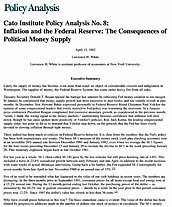Treasury Secretary Donald T. Regan opened the barrage last summer by criticizing Fed money creation as too meager. In January he complained that money supply growth had been excessive in past weeks, and too volatile overall in past months. In December, Sen. Howard Baker expressed personally to Federal Reserve Board Chairman Paul Volcker the opinion of some congressional leaders that overly restrictive Fed policy was worsening the recession. At a January press conference President Reagan complained that excessive monetary growth, as experienced in the previous month, “sends, I think, the wrong signal to the money markets,” undermining business confidence that inflation will slow down, though he has since spoken more positively of Volcker’s policies. Rep. Jack Kemp, the leading congressional supply-sider, has gone so far as to demand that Volcker step down, on the grounds that the Fed has been overly devoted to slowing inflation through tight money.
There indeed has been much to criticize in Federal Reserve behavior. It is clear from the numbers that the Fed’s policy has been both expansionary and erratic. The basic M‑1 measure of the money stock (cash plus checking accounts) rose at an incredible 26% annual rate between December 1981 and January 1982, even when we average the M‑1 figures for the four weeks preceding December 23 and January 20 to include the decline in M‑1 in the week preceding January 20. This monetary explosion began back in late October 1981.
For last year as a whole, M‑1 (then called M‑1B) grew by the less extreme but still price-boosting rate of 4.6%. This included a burst of 23.8% annualized growth between early February and late April, in addition to the recent increase, with some weeks of actual shrinkage intervening. Going back a bit further, the Fed expanded M‑1 interruptedly for seven months from late April to late November 1980 at an annual rate of 15%.[1]
Few of us need to be reminded what has happened to the value of our cash holdings in recent years. The numbers are dismaying. In the three months prior to September 1981, consumer prices for all items except food and energy rose at a 15.2% annual rate. During the 12-month period ending last October, the purchasing power of the dollar — as measured by the 10.2% rise in general consumer prices — shrank by a tenth. In the year prior to that period, consumer prices rose 12.2%. Since 1967 the dollar’s value has shrunk to less than 36 cents.[2]
Why have overall prices behaved in this way? The basic immediate cause is evident: The value of the dollar has been diluted by progressive additions made to the number of dollars (the stock of money) in circulation. The M‑1 money stock was expanded at an average annual rate of 6.1% between 1970 and 1975; prices rose at a 6.5% rate. Money averaged 7.1% annual growth between 1975 and 1980; prices grew at a 7.2% rate [3]
Blame for our nation’s erratic inflation, then, belongs squarely on the shoulders of our nation’s monetary authority. The Fed’s actions are responsible for the rate of growth of the total stock of dollars, and hence are responsible for the rate of dilution of the purchasing power of each existing dollar — the rate of price inflation. Changes in the willingness of the public to hold onto various forms of dollars, or changes in banking practices, may temporarily divert the rate of inflation from its appointed path, but over the longer haul (say, six months to a year) the predominance of the Fed is virtually complete. Other explanations of persistently rising prices simply do not wash.
Why has the Fed behaved in this way? There is not wide agreement among economists as to the best answer to this question. The answer differs depending on whether the analyst wants to explain the Fed’s actions taken last week, or a pattern of actions taken week-to-week over the past few years, or, more fundamentally, the overall behavior of the institution in the decades since its inception. We address ourselves here to this last concern. If we wish to understand the root cause of our erratic inflation, we must ask why the Fed is fundamentally prone to pursue a policy of uneven monetary expansion. There is a serious danger in focusing myopically on the monetary growth rates of last week, last month, or even last year: We may lose sight of the more important and enduring trends in money and prices. Also, we may overemphasize such cosmetic changes as the October 1979 guidelines emphasizing monetary targets over interest rate targets.
It is the institution of the Federal Reserve System that is responsible for our monetary disorder. Monetary trends cannot be explained merely by the personalities of the Fed chairman, the Board of Governors, or the Open Market Investment Committee. Personnel changes in the last decade have had no perceptible impact on Fed policy, whatever the changes in rhetoric. Monetary trends cannot be corrected, despite Rep. Kemp’s apparent wish to believe the contrary, merely by substituting new faces for old. Nor are we likely to accomplish much by bestowing yet more free advice on those now in charge. In order to understand what has happened to our money, and especially to find a remedy, we must look to the incentives and constraints effectively acting upon the suppliers of money.


